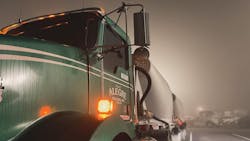The trucking industry is still grappling with Phase 3 of the Greenhouse Gas Emissions Standards. The contentious Phase 3 rule, part of the Clean Trucks Plan, requires manufacturers of heavy-duty vehicles to meet stringent standards in the coming years.
Finalized late last month, it requires increasing percentages of new zero-emission vehicle sales. By 2032, the EPA rule requires 25% of new long-haul and 40% of heavy-duty short-haul and medium-duty vehicles to be zero-emission.
See also: Trucking industry reacts to GHG3 rule pushing zero-emission adoption
Hitting where it hurts
Although the EPA places the burden on the manufacturers, trucking companies will be the most affected, as manufacturers pass the cost of research, development, and higher-priced equipment to customers. Trucking companies, already faced with the rising prices of maintaining cleaner-burning diesel engines and current emissions requirements, can see this problem coming.
“I really think the trucking community understands the predicament with this regulation,” Dan Ruoff told FleetOwner in an email. “Massive reductions in diesel-truck emissions already exist, plus more to come. The trucking industry has gone above and beyond in their part to clean the air.”
Ruoff is the maintenance supervisor for Lodi, California-based Frank C. Alegre Trucking, a fleet that hauls bulk food-grade products, food-grade liquids, and aggregate building materials. He is responsible for ensuring the fleet of 200-plus trucks reaches and maintains emissions compliance—both locally and federally. Even now, ahead of the EPA’s Clean Truck Plan’s 2027 start date, Alegre Trucking has already modified operations and invested a small fortune to comply with the California Air Resources Board.
“I’ve been here 32 years, so I’ve experienced the entire transition toward stricter emission regulations,” Ruoff told FleetOwner. “We have had to install exhaust filters on trucks before the manufacturers even built trucks with exhaust filters. We have had to retire trucks prematurely that still had plenty of life left in them—less than 600,000 miles. We have to budget now for the cleaning of all exhaust filters on a regular basis. We are constantly plagued with performance-related issues due to the complications that encompass the emission control systems.”
While Alegre Trucking operates in the state with the strictest emissions regulations, other states have adopted some of the same regulations.
See also: Forget the carrot. EPA uses stick
Phase 3 pushback
Trucking companies and drivers aren’t alone in their frustrations toward EPA and CARB. A number of trucking associations, including the American Trucking Associations, Truck and Engine Manufacturers Association, Owner-Operator Independent Drivers Association, and others, also pushed back on Phase 3 of the Clean Trucks Plan, even before it was finalized, citing that the rule focuses too much on BEVs, that industry technology is not yet ready to move forward with these strict regulations, and others.
“ATA opposes this rule in its current form because the post-2030 targets remain entirely unachievable given the current state of zero-emission technology, the lack of charging infrastructure, and restrictions on the power grid,” ATA President and CEO Chris Spear said shortly after the rule was finalized.
A year ago, EMA President Jed Mandel testified to the EPA, calling for the agency to “do its part” and modify the then-proposed rule to include an assessment of infrastructure development and allow for rule leniency where charging infrastructure lacked. He maintained that position after EPA finalized Phase 3, stating that “all parties need to be better aligned on the realistic timing for delivering the products and infrastructures critical to achieving the successful outcome we all want.”
OOIDA published a press release criticizing the rule the day it was finalized on March 29 referring to the rule’s impact on smaller trucking operations. “This administration seems dead set on regulating every local mom-and-pop business out of existence with its flurry of unworkable environmental mandates,” said Todd Spencer, OOIDA president.
Some manufacturers are up for EPA’s challenge
Federal regulations are not opposed by all industry stakeholders, however. In February, four vehicle and engine manufacturing and supply companies, part of an alliance called the Heavy-Duty Leadership Group, supported the rule and encouraged its finalization by the end of March. This group consists of Eaton, a power management company; Cummins, an engine manufacturer; BorgWarner, an automotive and e-mobility supplier; and Ford, a global automotive company. EPA finalized the rule just three days shy of the HDLG’s preferred timeline.
HDLG released a statement that included quotes from three of the companies on March 29. Eaton did not provide a representative quote but outlined its support for regulation, stating, “Eaton is ready to support emissions reduction goals with advanced powertrain and electrified vehicle technologies that can help achieve the Phase 3 Heavy Duty Greenhouse Gas rule.”
See also: Phase 3 of the Clean Trucks Plan: A tale of two trucking perspectives
The three other companies outlined support with quotes from company representatives. Both Cummins and Ford acknowledged the rule’s controversial nature and its “challenging” requirements.
“Cummins acknowledges the different perspectives on the rule but believes by continuing to work together with industry partners and the government, we can achieve our mutual goals to reduce emissions, create American jobs, and contribute to a stronger economy,” Shelley Knust, VP of product compliance and regulatory affairs at Cummins, said.
Ford also acknowledged the need for funding and incentives.
“The EPA’s new heavy-duty emissions rule is challenging, but Ford is working aggressively to meet the moment,” said Cynthia Williams, the global director of sustainability, homologation, and compliance at Ford. “We also need policymakers to pair emission standards with incentives and public investment so that we can continue to deliver on the next generation of vehicles and for our nation to lead the future of this industry.”
How will we get there
While the industry seems split on EPA’s decision to finalize GHG3, the associations and trucking industry professionals that oppose the rule can all agree with the desired goal behind it: a cleaner environment.
“Small-business truckers, who happen to care about clean air for themselves and their kids as much as anyone, make up 96% of trucking,” OOIDA’s Spencer said at the beginning of his statement that criticized the EPA rule.
ATA’s Chris Spear also emphasized that the “trucking industry is fully committed to the road to zero emissions.” EMA’s Mandel said, “We all are working toward the same common goals and desired end result.”
But it will take a joint effort from all involved parties to see a significant portion of the trucking industry running zero-emission vehicles, especially if 40%—the goal set by EPA—is the magic number.
Involving all parties includes listening to those with boots on the ground and rubber on the road—the truck owners and operators.
The owner of Alegre Trucking, Andress Alegre, said that the company supports all efforts to contribute to a cleaner environment, but like many in the industry, Alegre Trucking wants to do so “as the technology and feasibility to transition to BEVs becomes available.” Unfortunately, some individuals behind trucking companies and trucking organizations feel as though they aren’t being heard.
“They don’t care about what we have to say,” Ruoff told FleetOwner, referring to EPA and CARB.
Ruoff mentioned multiple examples from his own fleet and the trucking industry as a whole that outline diesel engine improvements developed over the years “to help clean the air,” but he wants to see this information get in front of the “right people.”
“EPA and CARB certainly don’t care, but somehow, we need to get this info to the lawmakers and the general public,” Ruoff said.
Ruoff showed FleetOwner a chart outlining the cleanliness of today’s diesel engines compared to those in the past and noted how much they have improved—from 10.7 grams per brake horsepower-hour of NOx emissions to 0.2. This is more than 90% cleaner than diesel engines of 2000, according to Allen Schaeffer, executive director of the Engine Technology Forum.
Reaching a 25-45% zero-emission future could come with excessive costs and disruption to the trucking industry. With the strides the industry has already made, is it worth investing that much money and forcing the adoption of BEVs regardless of their current viability in trucking? Trucking, after all, is just one of many industries that produces harmful emissions and has become much cleaner over time, with nearly zero NOx emissions at 0.2 g/bhp-hr and additional progress still to be made.
“Isn’t it time to allow the electrification of vehicles to progress at a realistic rate rather than prematurely force this transition onto an industry that has already done so much?” Ruoff asked.
About the Author
Jade Brasher
Senior Editor Jade Brasher has covered vocational trucking and fleets since 2018. A graduate of The University of Alabama with a degree in journalism, Jade enjoys telling stories about the people behind the wheel and the intricate processes of the ever-evolving trucking industry.

